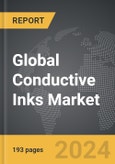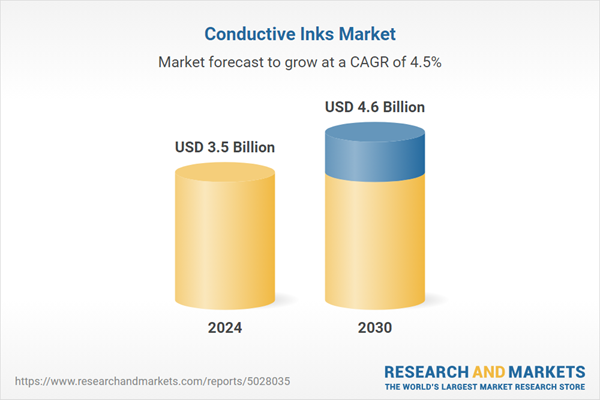The global market for Conductive Inks was valued at US$3.5 Billion in 2024 and is projected to reach US$4.6 Billion by 2030, growing at a CAGR of 4.5% from 2024 to 2030. This comprehensive report provides an in-depth analysis of market trends, drivers, and forecasts, helping you make informed business decisions. The report includes the most recent global tariff developments and how they impact the Conductive Inks market.
Segments: Type (Silver Ink, Carbon / Graphene, Carbon Nanoparticle, Dielectric, Other Types); Application (Photovoltaic, Displays, Sensors, Other Applications).
Geographic Regions/Countries: World; United States; Canada; Japan; China; Europe (France; Germany; Italy; United Kingdom; Spain; Russia; and Rest of Europe); Asia-Pacific (Australia; India; South Korea; and Rest of Asia-Pacific); Latin America (Argentina; Brazil; Mexico; and Rest of Latin America); Middle East (Iran; Israel; Saudi Arabia; United Arab Emirates; and Rest of Middle East); and Africa.
The analysts continuously track trade developments worldwide, drawing insights from leading global economists and over 200 industry and policy institutions, including think tanks, trade organizations, and national economic advisory bodies. This intelligence is integrated into forecasting models to provide timely, data-driven analysis of emerging risks and opportunities.
Global Conductive Inks Market - Key Trends and Drivers Summarized
What Are Conductive Inks and Why Are They Crucial to Modern Technology?
Conductive inks, a key innovation in modern technology, are specialized inks infused with conductive materials like silver, copper, carbon, and the emerging superstar, graphene. These inks allow electricity to flow through them, enabling the creation of flexible electronic circuits on various surfaces. Unlike traditional copper wiring and rigid electronic circuits, conductive inks provide the flexibility, scalability, and cost-efficiency required for new-age technologies like wearable devices, touch-sensitive surfaces, and smart packaging. By applying these inks onto substrates such as plastics, paper, textiles, and even glass, manufacturers can print conductive pathways that transmit electrical signals or energy without requiring cumbersome wiring. This versatile technology is instrumental in shrinking the size of electronic components, enabling everything from paper-thin RFID tags to flexible solar panels. As industries continue to prioritize lightweight, energy-efficient, and miniaturized electronics, conductive inks are becoming increasingly integral to innovation, offering not just functional improvements but also the potential to reshape manufacturing processes.Where Are Conductive Inks Used, and What’s Driving Their Expansion Across Sectors?
The versatility of conductive inks has led to widespread adoption across several high-growth industries, each leveraging the unique benefits of this technology. In the consumer electronics sector, they are a staple in touchscreens, flexible displays, antennas for near-field communication (NFC), and RFID tags, all of which require slim, flexible components that can be manufactured at scale. Similarly, the automotive industry has incorporated conductive inks in the production of printed sensors, heating elements, and even defogging systems in windshields, contributing to the evolution of connected and smart vehicles. Healthcare is another key sector, where conductive inks are used in the creation of wearable medical devices, such as skin-adhered biosensors and diagnostic patches, which monitor patient health with precision and comfort. The rise of smart packaging, which allows real-time tracking, tamper detection, and product authentication, has also fueled demand for printed electronics made possible by conductive inks. Moreover, the expansion of the Internet of Things (IoT) ecosystem, where a growing number of everyday objects are embedded with sensors and connectivity, is rapidly increasing the need for inexpensive, flexible, and scalable electronics - an area where conductive inks play a pivotal role.How Are Advances in Material Science Reshaping the Capabilities of Conductive Inks?
The evolution of conductive inks is closely tied to ongoing breakthroughs in material science, where the development of new conductive materials is continually improving the performance and applicability of these inks. Silver-based inks, long regarded for their superior conductivity, remain popular, but the high cost of silver has led researchers to explore more affordable alternatives, such as copper and carbon-based formulations. While copper is cheaper and widely available, it is prone to oxidation, which affects its conductivity over time. To address this, innovations in nanoparticle engineering and protective coatings have been employed to enhance copper's long-term stability in conductive inks. Carbon-based inks, particularly those leveraging carbon nanotubes, offer not only lower costs but also greater flexibility, making them ideal for bendable, wearable electronics. Perhaps the most groundbreaking development, however, comes from the use of graphene, a material composed of a single layer of carbon atoms arranged in a hexagonal lattice. Graphene's remarkable electrical conductivity, mechanical strength, and flexibility make it an excellent candidate for next-generation conductive inks. Additionally, advances in printing technologies such as inkjet printing, screen printing, and roll-to-roll printing have allowed for more precise deposition of these inks onto diverse substrates, reducing production costs and enhancing the potential for mass production. As these advancements continue, they are expanding the applications and pushing the boundaries of what conductive inks can achieve in fields like flexible electronics, energy storage, and printed sensors.What Factors Are Driving the Growth of the Conductive Inks Market?
The growth of the conductive inks market is driven by several factors, including the rapid development of flexible and wearable electronics, the expansion of electric vehicles, and the push for sustainability in manufacturing. Consumer demand for increasingly compact and portable electronic devices is a major driver, with manufacturers constantly seeking lighter, thinner, and more flexible components. Conductive inks enable the production of these components, allowing for the miniaturization of everything from smartphones and tablets to wearable devices like fitness trackers and smartwatches. In the automotive industry, the growing adoption of electric vehicles (EVs) and advanced driver-assistance systems (ADAS) has led to a surge in demand for innovative materials that can integrate sensors, heating elements, and other electronic components into lightweight, aerodynamic designs. Conductive inks fit this need perfectly by reducing the reliance on bulky wiring and rigid circuit boards. Another key driver is the rise of the IoT, which requires inexpensive, scalable solutions for embedding sensors and connectivity in everyday items. Conductive inks are essential for producing these low-cost electronics, which are increasingly used in smart homes, cities, and industrial automation. Sustainability is also a growing concern for manufacturers across industries. Conductive inks offer an eco-friendly alternative to traditional electronics by reducing the use of hazardous materials and enabling the production of recyclable or even biodegradable electronic components. This focus on greener technologies is particularly relevant in sectors such as packaging, where companies are exploring smart packaging solutions that not only enhance product functionality but also align with environmental goals. Together, these factors are shaping the future of the conductive inks market, positioning it as a key enabler of next-generation electronics.Report Scope
The report analyzes the Conductive Inks market, presented in terms of units. The analysis covers the key segments and geographic regions outlined below.Segments: Type (Silver Ink, Carbon / Graphene, Carbon Nanoparticle, Dielectric, Other Types); Application (Photovoltaic, Displays, Sensors, Other Applications).
Geographic Regions/Countries: World; United States; Canada; Japan; China; Europe (France; Germany; Italy; United Kingdom; Spain; Russia; and Rest of Europe); Asia-Pacific (Australia; India; South Korea; and Rest of Asia-Pacific); Latin America (Argentina; Brazil; Mexico; and Rest of Latin America); Middle East (Iran; Israel; Saudi Arabia; United Arab Emirates; and Rest of Middle East); and Africa.
Key Insights:
- Market Growth: Understand the significant growth trajectory of the Silver Ink segment, which is expected to reach US$1.9 Billion by 2030 with a CAGR of a 5.2%. The Carbon / Graphene segment is also set to grow at 4.4% CAGR over the analysis period.
- Regional Analysis: Gain insights into the U.S. market, valued at $926.3 Million in 2024, and China, forecasted to grow at an impressive 6.9% CAGR to reach $1.0 Billion by 2030. Discover growth trends in other key regions, including Japan, Canada, Germany, and the Asia-Pacific.
Why You Should Buy This Report:
- Detailed Market Analysis: Access a thorough analysis of the Global Conductive Inks Market, covering all major geographic regions and market segments.
- Competitive Insights: Get an overview of the competitive landscape, including the market presence of major players across different geographies.
- Future Trends and Drivers: Understand the key trends and drivers shaping the future of the Global Conductive Inks Market.
- Actionable Insights: Benefit from actionable insights that can help you identify new revenue opportunities and make strategic business decisions.
Key Questions Answered:
- How is the Global Conductive Inks Market expected to evolve by 2030?
- What are the main drivers and restraints affecting the market?
- Which market segments will grow the most over the forecast period?
- How will market shares for different regions and segments change by 2030?
- Who are the leading players in the market, and what are their prospects?
Report Features:
- Comprehensive Market Data: Independent analysis of annual sales and market forecasts in US$ Million from 2024 to 2030.
- In-Depth Regional Analysis: Detailed insights into key markets, including the U.S., China, Japan, Canada, Europe, Asia-Pacific, Latin America, Middle East, and Africa.
- Company Profiles: Coverage of players such as Advanced Nano Products Co., Ltd., Agfa-Gevaert NV, Bando Chemical Industries Ltd., Cartesian Co., C-INK Co., Ltd. and more.
- Complimentary Updates: Receive free report updates for one year to keep you informed of the latest market developments.
Some of the 44 companies featured in this Conductive Inks market report include:
- Advanced Nano Products Co., Ltd.
- Agfa-Gevaert NV
- Bando Chemical Industries Ltd.
- Cartesian Co.
- C-INK Co., Ltd.
- Creative Materials, Inc.
- Daicel Corporation
- Dow, Inc.
- DuPont de Nemours, Inc.
- Elephantech Inc.
- Fujikura Ltd.
- Henkel AG & Co. KGaA
- Heraeus Holding GmbH
- InkTec Co., Ltd.
- Johnson Matthey PLC
- Methode Electronics, Inc.
- NovaCentrix
- Parker Chomerics
- Poly-Ink
- PPG Industries, Inc.
- Promethean Particles Ltd.
- Sun Chemical Corporation
- Vorbeck Materials Corporation
Tariff Impact Analysis: Key Insights for 2025
Global tariff negotiations across 180+ countries are reshaping supply chains, costs, and competitiveness. This report reflects the latest developments as of April 2025 and incorporates forward-looking insights into the market outlook.The analysts continuously track trade developments worldwide, drawing insights from leading global economists and over 200 industry and policy institutions, including think tanks, trade organizations, and national economic advisory bodies. This intelligence is integrated into forecasting models to provide timely, data-driven analysis of emerging risks and opportunities.
What’s Included in This Edition:
- Tariff-adjusted market forecasts by region and segment
- Analysis of cost and supply chain implications by sourcing and trade exposure
- Strategic insights into geographic shifts
Buyers receive a free July 2025 update with:
- Finalized tariff impacts and new trade agreement effects
- Updated projections reflecting global sourcing and cost shifts
- Expanded country-specific coverage across the industry
Table of Contents
I. METHODOLOGYII. EXECUTIVE SUMMARY2. FOCUS ON SELECT PLAYERSIII. MARKET ANALYSISSOUTH KOREAREST OF ASIA-PACIFICARGENTINABRAZILMEXICOREST OF LATIN AMERICAIRANISRAELSAUDI ARABIAUNITED ARAB EMIRATESREST OF MIDDLE EASTIV. COMPETITION
1. MARKET OVERVIEW
3. MARKET TRENDS & DRIVERS
4. GLOBAL MARKET PERSPECTIVE
UNITED STATES
CANADA
JAPAN
CHINA
EUROPE
FRANCE
GERMANY
ITALY
UNITED KINGDOM
SPAIN
RUSSIA
REST OF EUROPE
ASIA-PACIFIC
AUSTRALIA
INDIA
LATIN AMERICA
MIDDLE EAST
AFRICA
Companies Mentioned (Partial List)
A selection of companies mentioned in this report includes, but is not limited to:
- Advanced Nano Products Co., Ltd.
- Agfa-Gevaert NV
- Bando Chemical Industries Ltd.
- Cartesian Co.
- C-INK Co., Ltd.
- Creative Materials, Inc.
- Daicel Corporation
- Dow, Inc.
- DuPont de Nemours, Inc.
- Elephantech Inc.
- Fujikura Ltd.
- Henkel AG & Co. KGaA
- Heraeus Holding GmbH
- InkTec Co., Ltd.
- Johnson Matthey PLC
- Methode Electronics, Inc.
- NovaCentrix
- Parker Chomerics
- Poly-Ink
- PPG Industries, Inc.
- Promethean Particles Ltd.
- Sun Chemical Corporation
- Vorbeck Materials Corporation
Table Information
| Report Attribute | Details |
|---|---|
| No. of Pages | 193 |
| Published | April 2025 |
| Forecast Period | 2024 - 2030 |
| Estimated Market Value ( USD | $ 3.5 Billion |
| Forecasted Market Value ( USD | $ 4.6 Billion |
| Compound Annual Growth Rate | 4.5% |
| Regions Covered | Global |









